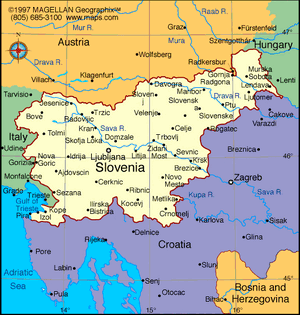Slovenia
| Author:Laxman Burdak, IFS (R) |

Slovenia is a country in Central Europe.[1] Ljubljana, the capital and largest city of Slovenia, is geographically situated near the centre of the country.[2]
Location
It is bordered by Italy to the west, Austria to the north, Hungary to the northeast, Croatia to the southeast, and the Adriatic Sea to the southwest.[3]
Slovenia is mostly mountainous and forested. Slovenes constitute over 80% of the country's population.[4] Slovene, a South Slavic language, is the official language.[5] Slovenia has a predominantly continental climate, with the exception of the Slovene Littoral and the Julian Alps. A sub-mediterranean climate reaches to the northern extensions of the Dinaric Alps that traverse the country in a northwest–southeast direction. The Julian Alps in the northwest have an alpine climate. Toward the northeastern Pannonian Plain, a continental climate is more pronounced.
History
Slovenia has historically been the crossroads of Slavic, Germanic, and Romance languages and cultures.[6]
Its territory has been part of many different states: the Roman Empire, the Byzantine Empire, the Carolingian Empire, the Holy Roman Empire, the Kingdom of Hungary, the Republic of Venice, the Illyrian Provinces of Napoleon's First French Empire, the Austrian Empire, and the Austro-Hungarian Empire.[7] In October 1918, the Slovenes co-founded the State of Slovenes, Croats, and Serbs.[8] In December 1918, they merged with the Kingdom of Serbia into the Kingdom of Yugoslavia.[9] During World War II, Germany, Italy, and Hungary occupied and annexed Slovenia, with a tiny area transferred to the Independent State of Croatia, a newly declared Nazi puppet state.[10] In 1945, it again became part of Yugoslavia. Post-war, Yugoslavia was allied with the Eastern Bloc, but after the Tito–Stalin split of 1948, it never subscribed to the Warsaw Pact, and in 1961 it became one of the founders of the Non-Aligned Movement.[11] In June 1991, Slovenia became the first republic to split from Yugoslavia and become an independent sovereign state.[12]
Slovenia is a developed country, with a high-income economy ranking highly in the Human Development Index.[13]
- ↑ Černe, Andrej (2004). Orožen Adamič, Milan (ed.). Gateway to Western, Central, and Southeastern Europe (PDF). Slovenia: A Geographical Overview. Association of the Geographical Societies of Slovenia. p. 127. ISBN 961-6500-49-X.
- ↑ https://www.ljubljana.si/en/about-ljubljana/
- ↑ "Slovenia – History, Geography, & People". Encyclopedia Britannica.
- ↑ https://www.infoplease.com/world/countries/slovenia
- ↑ Slovene language". Encyclopedia Britannica.
- ↑ Černe, Andrej (2004). Orožen Adamič, Milan (ed.). Gateway to Western, Central, and Southeastern Europe (PDF). Slovenia: A Geographical Overview. Association of the Geographical Societies of Slovenia. p. 127. ISBN 961-6500-49-X.
- ↑ "Slovenia – History, Geography, & People". Encyclopedia Britannica.
- ↑ Trgovčević, Ljubinka (18 July 2016). "Yugoslavia". International Encyclopedia of the First World War (WW1)
- ↑ "History and culture". I feel Slovenia.
- ↑ Sečen, Ernest (16 April 2005). "Mejo so zavarovali z žico in postavili mine" [They Protected the Border with Wire and Set up Mines]. Dnevnik.si (in Slovenian).
- ↑ "From Alignment to Non-Alignment: Yugoslavia Discovers the Third World". Wilson Center.
- ↑ Škrk, Mirjam (1999). "Recognition of States and Its (Non-)Implication on State Succession: The Case of Successor States to the Former Yugoslavia". In Mrak, Mojmir (ed.). Succession of States. Martinus Nijhoff Publishers. p. 5. ISBN 9789041111456.
- ↑ [https://www.heritage.org/index/country/slovenia "Slovenia Economy: Population, GDP, Inflation, Business, Trade, FDI, Corruption". The Heritage Foundation.

